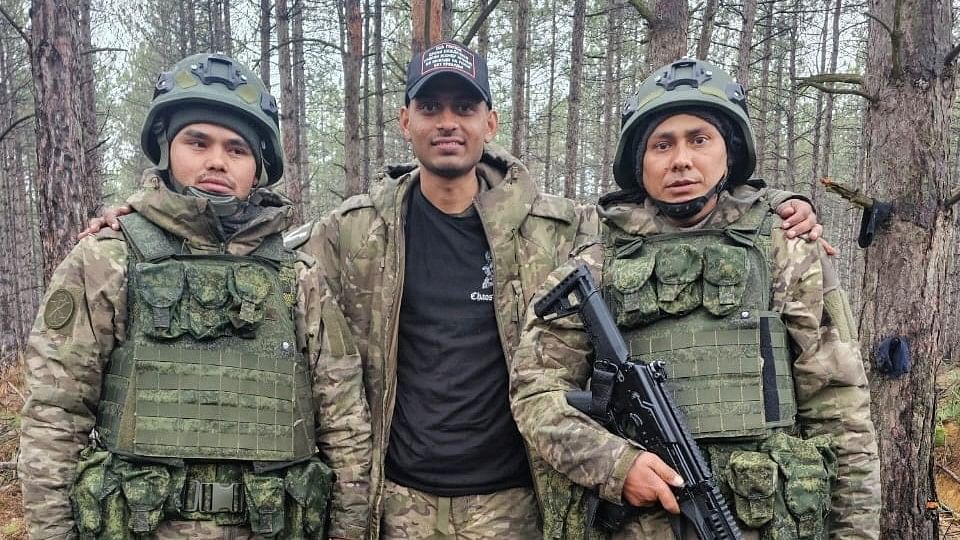
Hemil Mangukiya, middle, poses for a photograph with two other men in military uniform, in this undated handout picture. A missile strike killed Hemil in Ukraine on February 21.
Credit: Handout via Reuters Photo
Mohammed Afsan worked as a floor manager in a garment showroom in Hyderabad for almost 10 years, earned Rs 25000 per month, and lived with his wife and two children in a small rented house. So, when a recruitment agent offered him a job in Russia with a monthly salary of Rs 30000 initially and Rs 1.5 lakh within a few months as well as citizenship of the former Soviet Union nation for him and his family, he could not resist the temptation. He took loans to pay the agent Rs 3 lakh and took a flight from Chennai to Moscow in November. Four months later, on March 6, the Embassy of India in Moscow confirmed in a post on X that the 30-year-old had died.
Afsan was sent to Rostov-on-Don near the Russia-Ukraine border soon after he arrived in Moscow. After a brief training, he was sent to join the support staff of a Russian Army unit fighting in Ukraine. He was killed in the battlefield itself. “He went to Russia just to ensure a decent living for his family, but he didn’t know he would have to go to a war zone,” Afsan’s brother Mohammed Imran tells DH.
Hemil Mengukiya, who ran a small embroidery business in Surat, too didn’t know what was waiting for him when he left his home for Moscow in December. The recruitment agent had offered him a safe ‘security job’ with a monthly salary of Rs 2.5 lakh in Russia. But he not only had to dig trenches and carry ammunition for the Russian Army units in Ukraine but also had to fire rifles and machine guns at times. A missile strike killed him in Ukraine on February 21.
New Delhi has asked Moscow to ensure ‘early discharge’ of other Indians engaged for support jobs with the Russian Army in Ukraine. The government also advised citizens not to fall into the traps of human traffickers.
What made Afsan, Hemil, and others like them vulnerable to the too-good-to-be-true offers of the traffickers was the desperation to get decent jobs, always in short supply in India.
Pat Nibin Maxwell, 31, knew about the Israel-Hamas war that started on October 7 last year. But he didn’t think twice when he was offered a job at an agricultural farm in Israel. It would get him a salary much higher than his job as an electrician in the United Arab Emirates. A missile fired by Hezbollah from Lebanon killed him at Magaliot in northern Israel on March 4. His two other Indian coworkers were injured. His brother, Nivin, who also works in Israel, came for the funeral but will go back soon. “Several others whom we know are still employed in Israel. What will they do if they return to Kerala? Will they get decent jobs?” Pathrose Maxwell, the father of Nibin and Nivin, wonders.
No wonder thousands lined up when the state government of Haryana a few weeks back arranged a recruitment drive for skilled workers to be sent to Israel. The construction companies in Israel are keen to recruit workers from India to replace Palestinians, who have been denied work permits ever since the conflict began.
Nibin, who did an industrial training course in electrician, worked for three years in UAE. But the remuneration was not attractive. Hence, he took up a job in the agriculture sector in Israel and went in December, hardly two weeks after his elder brother Nivin also went to Israel.
“We got the visas through close relatives and friends who are already in Israel. The five-year visas were issued through government agencies and hence we did not have much apprehension over safety. Moreover, many of our friends and relatives are also there," said Maxwell.
Nibin left behind his pregnant wife and a five-year-old daughter.
Kerala often witnessed Malayalis migrating to trouble-torn areas. Even if the government imposes restrictions or gives travel advisories, job seekers and even students, prefer to travel to trouble-torn areas in search of better lives and livelihoods.
A Malayali nurse Nimisha Priya is now facing a death sentence in Yemen on charges of killing a Yemeni national. Financial crunches had forced her to stay back in Yemen despite the tension in the region and travel restrictions imposed by India.
In October, a Malayali nurse, Sheeja Ananad hailing from Kannur, and working as a caregiver in Israel, was injured in a missile attack.
In 2015 a batch of around 50 Malayali nurses in Yemen had a narrow escape.
Despite tension continuing in Ukraine, many Malayali students evacuated from the country had reportedly returned to the trouble-torn regions.
Harikrishnan Namboothiri, former chief executive officer of NORKA-Roots (Kerala government agency for the welfare of non-resident Keralites), says that even when serious trouble happens in many regions, most Malayalis working in those regions often prefer to stay back fearing job loss.
"Whenever any crisis is there in any foreign countries, we used to reach out to the Malayalis there through various sources like Malayali associations and advise them to return. But most of them ask what they will do once they return as most of them could be the lone breadwinners of their families back in Kerala. Moreover, many would also have huge financial commitments," he says.
“Similarly, unless there is an advisory from the Centre, we can't force anyone not to travel to any trouble-torn countries,” says Namboothiri.
As per Kerala Migration Survey - 2018 conducted by Centre for Development Studies, there were 21.2 lakh migrants from Kerala in various foreign countries, of which 90 percent were in West Asian countries, mainly UAE. An ongoing study, Kerala Migration Survey 2023 is likely to come up with the fresh trends in migrations, especially migration of Malayalis to new destinations in search of a job.
In January, Gujarat police's CID (crime) booked 14 agents in connection with a Dubai-Nicaragua chartered flight carrying 303 Indian passengers which was forced to return from France on suspicion of human trafficking. Sixty-six of the passengers were from Gujarat. The probe revealed that the agents were charging between Rs 60 lakh to Rs 80 lakh per individual to smuggle them to the US.
In 2022, Gujarat witnessed a shocking incident when a family of four persons including two children from Dingucha village in Gandhinagar district froze to death on the Canada-US border. They were forced to walk in the blizzard to cross the treacherous border. An investigation later revealed one of the trafficking agents was their relative. A year later in 2023, four more persons from a family were found dead in St Lawrence River on the US- Canada border. They were from the Mehsana district and were on their way to enter the US illegally on a boat that capsized.
“Migration from Gujarat may be linked to a lack of opportunities for the community as this community is largely farm-based and the scope for income from farming is shrinking because of rising real estate business at the cost of agricultural land. Further, the scope for gainful economic activities in the state for the aspiring youth is falling. This particular community has a history of intergenerational migration to countries in North America either by hook or crook and the glamour of resultant socio-economic status these community people enjoy back here in Gujarat,” says Rasananda Panda, a professor of economics and management at MICA, Ahmedabad.
He opines that Indian workers looking for livelihoods in the Russia-Ukraine or Israel-Hamas war zones may be termed a short-term opportunity in view of the emerging scope for semi-skilled to skilled labourers due to the conflict.
"Nevertheless, such migrations raise serious concerns on Vikasit Bharat and our ease of living where the young people are moving out of the country in search of jobs elsewhere," Panda adds.
Both Andhra Pradesh and Telangana send thousands of semi-skilled and unskilled workers to distant countries, mostly in search of blue-collar jobs.
“Emigration can be attributed to unemployment, agricultural stagnation, failure of the state level institutions to provide the required support and the milieu for growth of secondary and the tertiary sectors of the state economy or demographic growth creating a surplus of labour,” N Ganesh Naik, an assistant professor at the Yogi Vemana University of Andhra Pradesh, says.
Naik, who conducted a study on emigration from Telugu states, tells DH that Indian emigration to Gulf countries is completely different from migration to other countries like USA, UK, Australia, and other developed countries. “Approximately, around 5 lakh persons from Telangana are currently employed in the Gulf countries. On a comparative note, emigrants from Kerala are graduates and professionally employed in white-collar jobs in the gulf, Telangana emigrants are employed in blue-collar jobs,” he adds.
He says that migrants mostly comprise small marginal farmers, tenant farmers, and rural labourers. More recently youths have also migrated from northern districts of Telangana, like Karimnagar, Nizamabad, Adilabad, and from Kadapa and Chittor from Andhra Pradesh.
As per the government data, the states of Telangana and Andhra Pradesh accounted for over 7.51 lakh emigration clearances during the last decade between 2007-2016 with an average annual flow of 75000 Telugu-speaking workers.
An NSSO report, which was not officially released, showed that the unemployment rate in 2017-18 surged to 6.1%, the highest in 45 years. While independent research and data showed stress and an increase in unemployment in the economy following the 2016 demonetization of high-value bank notes, Prime Minister Narendra Modi's government discontinued the Labour Bureau’s quarterly enterprise survey as well as the annual Employment-Unemployment survey. The government came out with a new methodology called Periodic Labour Force Survey (PLFS), which relies on provident fund data to calculate employment. As per the Annual PLFS reports, the unemployment rate in India declined to 3.2% in 2022-23 from 4.1% recorded in 2021-22 and 4.2% in 2020-21. However, this does not mean that 96.8% of the working-age population during the year 2022-23 were employed. This merely indicates the proportion of the working-age population that wants to be employed to earn wages or profits through work but is unable to find a job. The Centre for Monitoring Indian Economy (CMIE) data shows a decline in the participation of youth (15 to 29 years) in the workforce.
With two Indians killed and several being forced to fight for Russia in the war against Ukraine, the CBI had cracked human trafficking networks sending youth to the conflict zone promising them lucrative jobs. A Russian woman and two Indians based in Russia were named by the CBI in its FIR.
The opposition Congress attacked the BJP-led government over Indians being duped and sent to Russia to work for the military saying they were being held 'hostage' there as a 'mrit kaal' is prevailing back home.
The Congress is planning to use it to counter the BJP’s ‘Vikshit Bharat’ campaign during the Lok Sabha elections. “The unemployment situation is so terrible here that India's youths are forced into seeking jobs as soldiers abroad and risk their lives in war-torn Israel and Russia,” Jairam Ramesh, the party’s general secretary (communication), says.
